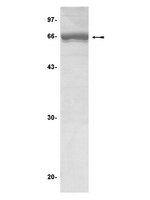The substrate specificity and structure of mitogen-activated protein (MAP) kinase-activated protein kinase-2.
Stokoe, D, et al.
Biochem. J., 296 ( Pt 3): 843-9 (1993)
1993
Show Abstract
The substrate specificity of mitogen-activated protein (MAP) kinase-activated protein kinase-2 (MAPKAP kinase-2) was investigated by using synthetic peptides related to the N-terminus of glycogen synthase. The minimum sequence required for efficient phosphorylation was found to be Xaa-Xaa-Hyd-Xaa-Arg-Xaa-Xaa-Ser-Xaa-Xaa, where Hyd is a bulky hydrophobic residue (Phe > Leu > Val >>> Ala), and the peptide Lys-Lys-Phe-Asn-Arg-Thr-Leu-Ser-Val-Ala was phosphorylated with a Km of 9.3 microM and Vmax. of 10 mumol/min per mg. MAPKAP kinase-1 (a homologue of ribosomal protein S6 kinase) also requires an arginine three residues N-terminal to the serine (position n-3), but not a hydrophobic residue at position n-5. Neither MAPKAP kinase-1 nor MAPKAP kinase-2 could tolerate a proline residue at position n + 1, indicating that their specificities do not overlap with that of MAP kinase. The specificity of calmodulin-dependent protein kinase-II resembled that of MAPKAP kinase-2, except that it could tolerate replacement of the arginine by a lysine and the phosphorylation-site serine by a threonine residue. Partial cDNAs encoding MAPKAP kinase-2 were isolated from rabbit and human skeletal muscle and human teratocarcinoma libraries, and Northern-blotting experiments revealed a single 3.3 kb mRNA transcript present at similar levels in six human tissues examined. The catalytic domain was most similar (35-40% identity) to calmodulin-dependent protein kinases II and IV, phosphorylase kinase, putative serine kinase H1 and the C-terminal domain of MAPKAP kinase-1, which form one branch of the protein kinase phylogenetic tree. The sequence N-terminal to the catalytic domain is proline-rich and contains two putative SH3-binding sites. The threonine residue phosphorylated by MAP kinase lies immediately C-terminal to the catalytic domain and is followed by a nuclear localization signal, Lys-Lys-(Xaa)10-Lys-Arg-Arg-Lys-Lys, near the C-terminus. | | 8280084
 |
MAPKAP kinase-2; a novel protein kinase activated by mitogen-activated protein kinase.
Stokoe, D, et al.
EMBO J., 11: 3985-94 (1992)
1992
Show Abstract
A novel protein kinase, which was only active when phosphorylated by the mitogen-activated protein kinase (MAP kinase), has been purified 85,000-fold to homogeneity from rabbit skeletal muscle. This MAP kinase activated protein kinase, termed MAPKAP kinase-2, was distinguished from S6 kinase-II (MAPKAP kinase-1) by its response to inhibitors, lack of phosphorylation of S6 peptides and amino acid sequence. MAPKAP kinase-2 phosphorylated glycogen synthase at Ser7 and the equivalent serine (*) in the peptide KKPLNRTLS*VASLPGLamide whose sequence is similar to the N terminus of glycogen synthase. MAPKAP kinase-2 was resolved into two monomeric species of apparent molecular mass 60 and 53 kDa that had similar specific activities and substrate specificities. Peptide sequences of the 60 and 53 kDa species were identical, indicating that they are either closely related isoforms or derived from the same gene. MAP kinase activated the 60 and 53 kDa forms of MAPKAP kinase-2 by phosphorylating the first threonine residue in the sequence VPQTPLHTSR. Furthermore, Mono Q chromatography of extracts from rat phaeochromocytoma and skeletal muscle demonstrated that two MAP kinase isoforms (p42mapk and p44mapk) were the only enzymes in these cells that were capable of reactivating MAPKAP kinase-2. These results indicate that MAP kinase activates at least two distinct protein kinases, suggesting that it represents a point at which the growth factor-stimulated protein kinase cascade bifurcates. | | 1327754
 |












